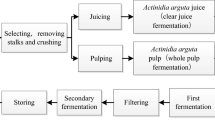Abstract
Wine from sapota (Achras sapota Linn.) fruit was prepared by fermenting with wine yeast (Saccharomyces cerevisiae) to preserve the nutritional, antioxidative and functional properties of the fruits. The wine had the following proximate compositions: total soluble solids, 2.38°Brix; total sugar, 3.28 g/100 ml; titratable acidity (TA), 1.29 g tartaric acid/100 ml; pH, 3.02; total phenolics, 0.21 g/100 ml; β-carotene, 22 μg/100 ml; ascorbic acid, 1.78 mg/100 ml; lactic acid, 0.64 mg/100 ml; and ethanol content, 8.23% (v/v). The sapota wine had a 2,2-diphenyl-1picryl hydrazyl (DPPH)-scavenging activity of 46% at a dose of 250 μg/ml. Infrared spectroscopy revealed the presence of alcohols, phenols, anhydrides, amides, esters and alkenes in the sapota wine. Principal component analysis (PCA) reduced the 10 original analytical and proximate variables (total soluble solids, total sugar, TA, pH, phenol, β-carotene, ascorbic acid, lactic acid, ethanol and DPPH-scavenging activity) into four independent components, which accounted for 87.55% variations. Sensory evaluation was carried out by 16 panellists on various attributes like taste, aroma, flavour, colour/appearance and aftertaste. The results showed that the flavour, taste and aroma of sapota wine was strongly liked by the panellists and there was no significant difference (p<0.05) between the two replicates for most sensory parameters.
Similar content being viewed by others
References
Sulladmath UV, Reddy MA (1990) Sapota. In: Bose TK, Mitra SK (eds) Fruits: tropical and subtropical. Naya Prakash Publishers, Kolkata, pp 565–591
Ramulu P, Rao PU (2003) Total, insoluble and soluble dietary fibre contents of Indian fruits. J Food Comp Anal 16:677–685
Gurusharansingh K (2001) Sapota for health. Agro India 6:25–26
Pervez H, Ahmed R, Ifzal SM (1982) Studies on Archas sapota. Part 1. The amino acids and carbohydrates content of the fruits of Archas sapota. J Chem Soc Pak 4(1):27–31
Ramachandra VA (2006) Production and marketing of sapota in Northern Karnataka: an economics analysis. PhD Thesis, University of Agricultural Sciences, India
Maya TP, John J, Rajendrakumar P (2003) Sapota beverage powder for instant chikku shake. In: Proceedings of 5th International Food Convention, CFTRI, Mysore, India
Morais PLD, Oliveira LC, Alves RE, Alves JD, Paiva A (2006) Amadurecimiento de sapoti (Manilkara zapota L.) submetido ao 1-metilciclopropeno. Rev Bras Fruticultura 28:369–373
Madan M, Ullasa BA (1993) Post harvest losses in fruits. In: Chadha KL, Pareek OP (eds) Advances in horticulture. Vol. IV. Malhotra Publishing House, New Delhi, pp 1795–1810
Martirosyan DM (2011) Functional foods and chronic diseases: science and practice. Food Science Publisher, Dallas, USA
Ray RC, Panda SK, Swain MR, Sivakumar PS (2012) Proximate composition and sensory evaluation of anthocyanin rich purple sweet potato (Ipomoea batatas L.) wine. Int J Food Sci Technol 47(3):452–458
Panda SK, Swain MR, Singh S, Ray RC (2013) Proximate compositions of a herbal purple sweet potato (Ipomoea batatas L.) wine. J Food Process Preserv 37(5):596–604
Panda SK, Sahu UC, Behera SK, Ray RC (2014) Fermentation of bael (Aegle marmelos L.) fruits into wine with antioxidants. Food Biosci 5:34–41
Amerine MA, Ough C (1980) Methods for analysis of musts and wines. Wiley-Inter Science Publication, New York, NY
Marxen KK, Vanselow H, Lippemeier S, Hintze R, Ruser A, Hansen U (2007) Determination of DPPH radical oxidation caused by methanolic extracts of some microalgal species by linear regression analysis of spectrophotometric measurements. Sensors 7:2080–2095
Kilcast D, Subramanian P (2000) The stability and shelflife of food. Woodhead Publishing Limited, Cambridge, UK
Aroyeun SO, Olubamiwa O, Ogunjobi MAK (2005) Development of wine from infused tea leaves (Camellia sinensis). Br Food J 107:34–41
Soni SK, Bansal N, Soni R (2009) Standardization of conditions for fermentation and maturation of wine from amla (Emblica officinalis Gaertn.). Nat Prod Rad 8:436–444
Saigal D, Ray RC (2007) Winemaking: microbiology, biochemistry and biotechnology, In: Ray RC, Ward OP (eds) Microbial biotechnology: horticulture, Vol. 3. Science Publishers, New Hampshire, pp. 1–33
Liu SQ (2003) Practical implications of lactose and pyruvate metabolism by lactic acid bacteria in food and beverage fermentations. Int J Food Microbiol 83:115–131
Mohanty S, Ray P, Swain MR, Ray RC (2006) Fermentation of cashew (Anacardium occidentale L.) to wine. J Food Process Preserv 30:314–322
Chowdhury P, Ray RC (2007) Fermentation of Jamun (Syzgium cumini L.) fruits to form red wine. ASEAN Food J 14:15–23
Sichel G, Corsaro C, Scalia M, Di Bilio AJ, Bonomo RP (1991) In vitro scavenger activity of some flavonoids and melanins against O2. Free Radic Biol Med 11:1–8
Soleas GL, Diamandis EP, Goldberg DM (1997) Wine as a biological fluid: history, production, and role in disease prevention. J Clin Lab Anal 11:287–313
Assuncao RB, Mercandate AZ (2003) Carotenoids and ascorbic acid composition from commercial products of cashew apple (Anacardium occidentale L.). J Food Comp Anal 16:647–657
Phillips KM, Tarrago-trani MT, Gebhardt SE, Exler J, Patterson KY, Haytowitz DB, Pehrsson PR, Holden JM (2010) Stability of vitamin C in frozen raw fruits and vegetable homogenates. J Food Comp Anal 23:253–259
Mochizuki M, Yamazaki S, Kano K, Ikeda T (2002) Kinetic analysis and mechanistic aspects of autoxidation of catechins. Biochim Biophys Acta 1569:35–44
Weissenberg M, Levy A, Schaeffler I, Menagem E, Barzilai M (1997) Rapid isocratic HPLC analysis of beta carotene in red peppers (Capsicum annuum L.) and food preparations. Chromatographia 46:399–403
Akubor PI, Obio SO, Nwadomere KA, Obiomah E (2003) Production and quality evaluation of banana wine. Plant Foods Hum Nutr 58:1–6
Versari A, Parpinello GP, Scazzina F, Rio DD (2010) Prediction of total antioxidant capacity of red wine by Fourier transform infrared spectroscopy. Food Control 21:786–789
Stuart BH (2004) Infrared spectroscopy: fundamentals and applications. Wiley, Chichester, UK
Hair JF, Anderson RE, Tatham RL, Black WC (1998) Multivariate data analysis. Pearson Education, Upper Saddle River, NJ
Stevens J (1992) Applied multivariate statistics for the social sciences. Lawrence Erlbaum Associates, Hillsdale, NJ
Author information
Authors and Affiliations
Corresponding author
Rights and permissions
About this article
Cite this article
Panda, S.K., Sahu, U.C., Behera, S.K. et al. Fermentation of sapota (Achras sapota Linn.) fruits to functional wine. Nutrafoods 13, 179–186 (2014). https://doi.org/10.1007/s13749-014-0034-1
Received:
Accepted:
Published:
Issue Date:
DOI: https://doi.org/10.1007/s13749-014-0034-1




